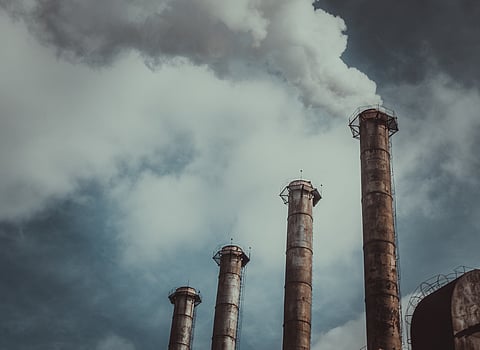

UNFCCC’s 2025 Synthesis Report finds global emissions beginning to decline for the first time since the Paris Agreement
64 new or updated national climate plans show broader participation and stronger integration across sectors
Emissions projected to fall 17% below 2019 levels by 2035 — but still off track for 1.5°C goal
Experts call for faster finance, energy transition, and just implementation ahead of COP30 in Belém
Global greenhouse gas emissions are finally beginning to decline, marking what the UN Framework Convention on Climate Change (UNFCCC) has called the first real sign of “bending the curve downward” since the Paris Agreement was adopted a decade ago.
The finding comes from the 2025 UNFCCC Synthesis Report, released on October 28, 2025, ahead of the 30th Conference of Parties (COP30) to the UNFCCC. The report compiled 64 new or updated Nationally Determined Contributions (NDCs) submitted by September 30. Together, these plans cover around one-third of global emissions and represent the most comprehensive climate commitments yet.
The report shows a steady rise in ambition: 89 per cent of countries now have economy-wide emission reduction targets, 73 per cent include adaptation components, and nearly one-third include measures addressing loss and damage—especially among small island developing states.
If fully implemented, these pledges would cut emissions by around 17 per cent below 2019 levels by 2035, with a collective peak expected before 2030 and a downward trajectory thereafter. Yet the UNFCCC warns the pace still falls short of what is needed to limit warming to 1.5°C.
Humanity is now clearly bending the emissions curve downwards for the first time, although still not nearly fast enough The direction of travel is improving every year — but we need much more speed, and stronger support for countries to act.
Simon Stiell, UN climate change executive secretary
The 2025 NDCs demonstrate broader policy coverage than ever before, with 88 per cent referencing the outcomes of the COP28 Global Stocktake. Many align short-term targets with net-zero pathways between 2040 and 2060.
Nearly 90 per cent of new NDCs now integrate climate considerations into national laws and economic planning, while 70 per cent reference just transition principles. The UNFCCC also noted a growing emphasis on the role of forests, oceans and Indigenous Peoples, as well as youth participation and gender equity. Ocean-based climate actions saw a 39 per cent increase, with 78 per cent of NDCs now mentioning marine resilience, renewable energy or blue carbon solutions.
Climate leaders and analysts welcomed the downward trend but cautioned that ambition gaps persist, with some major emitters yet to submit updated NDCs.
“Current analyses show global emissions may level off by 2030, but we’re still far from Paris alignment,” said Madhura Joshi, programme lead at E3G’s Asia Hub, said in a statement. “Developing countries’ ability to step up depends on finance, technology, and capacity-building. At COP30, leaders must show that ambition and equity can go hand in hand.”
Aarti Khosla, director of Climate Trends, said India exemplifies the “new wave” of integrated climate governance. “India’s semi-federal model—with central targets and state-led execution—is a shift toward multi-level climate action. From Tamil Nadu’s Green Climate Company to Gujarat’s solar leadership, states are becoming co-architects of national decarbonization,” she said, calling COP30 “the Implementation COP.”
Bruce Douglas, chief executive office of the Global Renewables Alliance, noted that 2025 marks a “turning point” but urged governments to accelerate enabling policies.
“The vast majority of NDCs now include renewable energy targets, and the emissions curve is finally bending. But targets alone won’t deliver 1.5°C — we need faster permitting, stronger grids, and predictable finance to turn NDCs into real megawatts,” he said in a statement.
Civil society leaders offered sharper critiques. Rachel Cleetus of the Union of Concerned Scientists said the world is “on the verge of exceeding 1.5°C of warming permanently.”
“It’s enraging and heartbreaking that after ten years, we’re still not acting fast enough. World leaders must come to COP30 with real ambition, not fossil-fuel excuses,” she said.
The report also highlighted growing inclusion of ocean and forest protection measures, reflecting shifts since COP28’s focus on nature-based and blue economy solutions. Anna-Marie Laura of the Ocean Conservancy called the trend “a long-overdue recognition” of the ocean’s role in climate action.
“Seeing 78 per cent of countries highlight the ocean is a reason to celebrate,” she said. “But we must stay laser-focused on emissions cuts — our ocean allies can only do so much if fossil fuel use keeps rising.”
The road to Belém
As negotiators prepare for COP30 in Belém, Brazil, the synthesis report sets the tone for what many are calling the “Implementation COP.” The challenge now, experts say, is translating NDC pledges into rapid action backed by finance and credible policy delivery.
“Countries are finally setting out the stepping stones to net zero,” Stiell said. “The next five years must be about building the bridge between plans on paper and emissions in the atmosphere.”